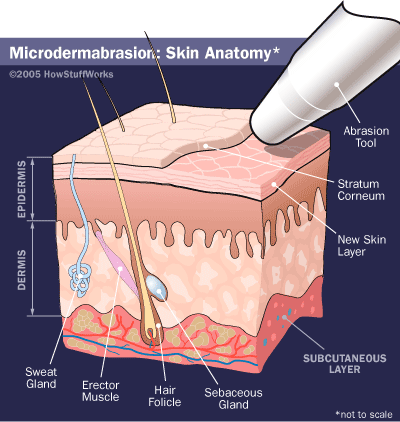Microdermabrasion is one of the more recent skin-care techniques to have crossed over from Hollywood to the mainstream. It's being advanced as an "instant facelift" -- an effective alternative to costlier and more invasive procedures like plastic surgery and Botox injections. Recently, more and more men are trying it, instead of pursuing cosmetic surgery.
Microdermabrasion is a general term for the application of tiny rough grains to buff away the surface layer of skin.It's usually done to the face, chest, neck, arms or hands. Before we can understand how microdermabrasion does what it does, it's important to understand how skin works.
Microdermabrasion Effects
The idea is that if you remove or break up the stratum corneum, the body interprets that as a mild injury and rushes to replace the lost skin cells with new and healthy ones. In the first hour after treatment, this causes mild edema (swelling) and erythema (redness). Depending on the individual, these side effects can last anywhere from an hour to two days.
This process has many beneficial effects.
-
With the stratum corneum gone, the skin's surface is improved.
-
The healing process brings with it newer skin cells that look and feel smoother.
-
Some of the skin's visible imperfections, like sun damage, blemishes and fine lines, are removed.
-
Without the stratum corneum acting as a barrier, medicinal creams and lotions are more effective because more of their active ingredients and moisture can find their way down to the lower layers of skin.
As microdermabrasion temporarily removes some moisture from the skin, it is always followed by the application of moisturizing creams.

Your skin is made up of two main layers, the epidermis and the dermis. The epidermis is the layer closest to the outside world. It's a set of dead skin cells on top of another layer of cells that are in the process of maturing. The topmost layer is called the stratum corneum. The stratum corneum mostly acts as a barrier between the outside world and the lower skin layers. It keeps all but the smallest molecules from getting through.
When you put lotions or creams on your skin, some of the moisture passes through the stratum corneum, but not all of it. This layer is home to many minor skin imperfections like fine wrinkle lines and blemishes.
All of the action in microdermabrasion takes place at the level of the stratum corneum. Since it only really targets the epidermis (and not the dermis), it is more accurate to call it micro-epi-dermabrasion. Affecting deeper layers of skin would be painful and harmful
MICRODERMABRATION
$60
MICRODERMABRASION CANDIDATES
Microdermabrasion works especially well as a way to clean out clogged pores. It's a useful alternative for patients whose skin is too sensitive to use anti-acne drugs like Retin-A. It's not recommended for those who have active oral herpes. Here's a list of the conditions that make someone unsuited for microdermabrasion:
-
Active rosacea
-
Fragile capillaries
-
Vascular lesions
-
Widespread acne
-
Herpetic lesions (herpes)
-
Warts
-
Open sores
-
Skin lesions
-
Anyone who takes anti-coagulants
-
Eczema
-
Dermatitis
-
Psoriasis
-
Erythematosus (lupus)
-
Diabetes mellitus
How is it done?
The technician steadily moves the tool over the target area, applying even and steady pressure to remove the stratum corneum without affecting the lower skin layers. A standard session usually consists of one to three passes with the tool. In most cases, the patient is then asked to apply specialized lotions and creams to the affected area between sessions. This rehydrates the area and assists in promoting healthier new skin.
.png)


